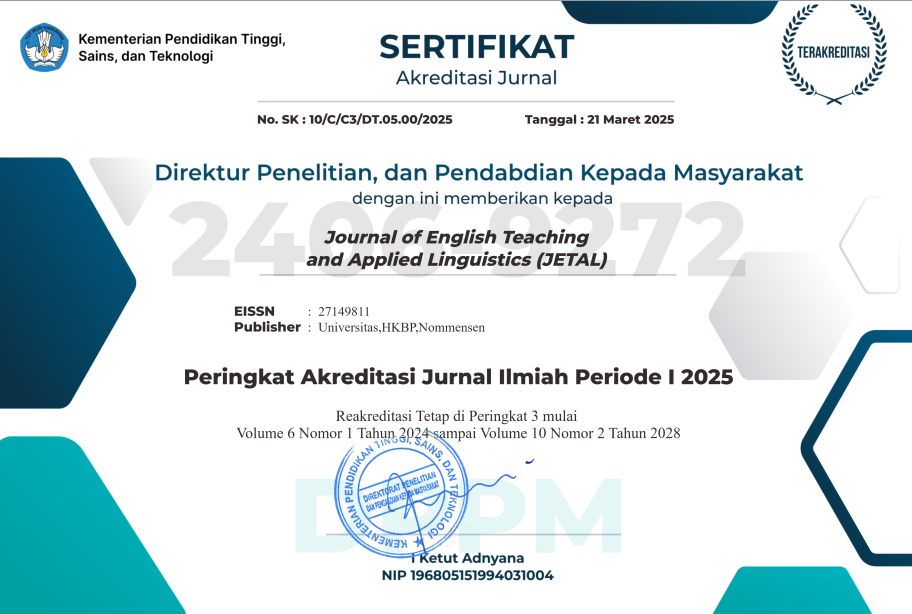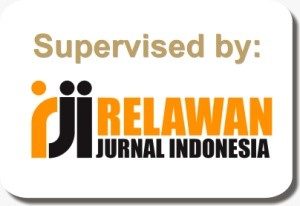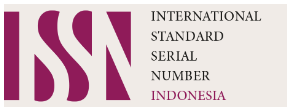TRANSLATION STRATEGIES IN TRANSLATING IDIOM IN THE FILM OF WEDNESDAY (2022)
Abstract
This study, entitled “Translation Strategies in Translating Idioms in the Film of Wednesday (2022)” analyzes the strategies used to translate English idioms into Indonesian subtitles. Translation is the process of converting text or speech from one language to another, with a primary emphasis on accurately conveying meaning and cultural context. The purpose of this study is to determine the strategies used in translating idioms in the film Wednesday (2022) and to determine the dominant strategies used in translating idioms in the film Wednesday (2022). This study applies a qualitative research design with a descriptive approach to analyze the translation strategies used in translating idioms in the film Wednesday (2022). Using Mona Baker’s (1992) framework, the study identified 42 idioms and categorized them into five strategy types: Translation by a Phrase or Descriptive Expression, by a More General Word, by Cultural Substitution, by a More Neutral or Less Expressive Word, and Using Loan Words or Loan Plus Explanation. This qualitative descriptive research found that Translation by a Phrase or Descriptive Expression was the most dominant strategy (55%), followed by More General Word (19%), Cultural Substitution (14.2%), More Neutral or Less Expressive Word (9.5%), and Loan Words (2.3%). The frequent use of descriptive translation reflects the need for clarity and cultural adaptation in audiovisual media. The findings support Baker’s theory and show that translating idioms involves not only linguistic conversion but also attention to context, tone, and cultural nuances, especially in a series like Wednesday known for its dark humor and sarcasm.
References
Albir, L. M., & Hurtado, A. (2002). Translation techniques revisited: A dynamic and functionalist approach. Meta, XLVII(4), 498–512.
Baker, M. (1992). In Other Words: A Coursebook on Translation Second Edition. In In Other Words: A Coursebook on Translation Second Edition. https://doi.org/10.4324/9781315619187
Chanthong, P., & Kaowiwattanakul, S. (2024). A Study of Strategies for Translating English Idioms in Subtitles from Riverdale Series into Thai. World Journal of English Language, 14(3), 231–241. https://doi.org/10.5430/wjel.v14n3p.
Chen, X., Du, Y., Qu, M., & Gao, S. (2022). A Study on the Effect of L1 to L2 Transfer on the Production of Idiomatic Expressions in L2 Among Mandarin-speaking Intermediate Learners of English. Proceedings of the 2021 International Conference on Public Art and Human Development (ICPAHD 2021), 638(Icpahd 2021), 608–616. https://doi.org/10.2991/assehr.k.220110.117
Cintas, J. D., & Anderman, G. (2008). Audiovisual translation: Language transfer on screen. Audiovisual Translation: Language Transfer on Screen, 1–256. https://doi.org/10.1057/9780230234581
Creswell, J. W. (2014). Research design. In Post-Communist Welfare States in European Context. https://doi.org/10.4337/9781784711986.00010
Czeisel, M. J., & Smith, V. D. (2020). CUNY Academic Works University Music Students ’ Choice of Music Listening Sources : Use of Library Resources as Compared with Non-Academic Streaming Services How does access to this work benefit you ? Let us know !
Diantri, D. N. I., Prabowo Kusumo, & Maria Yosephin. (2023). an Analysis of Idiomatic Expressions Used By Content Creators on Tiktok. Didaktik : Jurnal Ilmiah PGSD STKIP Subang, 9(04), 701–712. https://doi.org/10.36989/didaktik.v9i04.1645
Fadwati, A. (2021). Baker ’ s Strategy in Translating Idiomatic Expressions in Fast & Furious : Hobbs and Shaw ’ s Movie Subtitles. 574(Iset 2020), 198–204.
Gambier, Y. (2018). Published in : Reception Studies and Audiovisual Translation ( BTL 141 , 2018 , pages 43-66 . Amsterdam : John Benjamins ) Translation Studies , Audiovisual Translation and Reception. 43–66.
Krisandini, M. T. K., & Sutrisno, A. (2022). The Translation of Idioms from English into Indonesian: The Case of J.K. Rowling’s Harry Potter and the Half-Blood Prince. Lexicon, 8(1), 24. https://doi.org/10.22146/lexicon.v8i1.65904
Kunnim, S. (2023). Metaphor Types And Metaphor Translation Strategies : A Case Study of The Netflix Series “ Wednesday ” Metaphor Types And Metaphor Translation Strategies : A Case Study Of The Netflix Series “ Wednesday .”
Leatemia, C. J. (2018). Strategies In Translating Idiomatic Expressions In “The Nightmare Before Christmas” Movie. http://repository.ub.ac.id/id/eprint/166693/
Li, S., Chen, J., Yuan, S., Wu, X., Yang, H., Tao, S., & Xiao, Y. (2024). Translate Meanings, Not Just Words: IdiomKB’s Role in Optimizing Idiomatic Translation with Language Models. Proceedings of the AAAI Conference on Artificial Intelligence, 38(17), 18554–18563. https://doi.org/10.1609/aaai.v38i17.2981
Martinez-Flor, A., & Soler, E. A. (2007). Developing Pragmatic Awareness of Suggestions in the EFL Classroom: A Focus on Instructional Effects. Canadian Journal of Applied Linguistics/Revue Canadienne de Linguistique Appliquee, 10(1), 47–76. https://doi.org/10.30486/RELP.2023.1984316.1457
Murar, I. (2010). Pragmatic and Functional Uses of Idioms. Analele Universităţii Din Craiova. Seria Ştiinţe Filologice. Lingvistică, 1–2, 146–156.
Rizka Nuraini, & Dr. Frans Sayogie, M.Pd. (2024). Translation Accuracy of English Idiomatic Expression into Indonesian in Soul Film Subtitle by Disney+ Retail. Linguistik Terjemahan Sastra (LINGTERSA), 5(1), 30–37. https://doi.org/10.32734/lingtersa.v5i1.12317
Sinambela, E., Manik, S., Siregar, R., Manurung, L. W., & Saragi, C. N. (2023). An Analysis of Translation Strategies Used by Students in Translating Idioms at the Second Grade of SMA Kalam Kudus. International Journal of Membrane Science and Technology, 10(2), 550–557. https://doi.org/10.15379/ijmst.v10i2.1265
Sinambela, E., Sipayung, R. W., Herman, H., Purba, R., Fatmawati, E., Ngongo, M., & Manurung, L. W. (2024). Investigating translation strategies used by students in translating metaphors from english into indonesian: A case study on translation. Research Journal in Advanced Humanities, 5(4), 780–790. https://doi.org/10.58256/m8qeqf93
Sipayung, K. T., Pasaribu, A. N., & Sinaga, N. T. (2024). Common Problems and Overt Errors in Translating Idioms in The Film Maleficent. Eurasian Journal of Applied Linguistics, 10(2), 23–31. https://doi.org/10.32601/ejal.10203
Suriadi, M. A., Kirana, P. M., & Selatan, K. T. (2024). Translation strategy and accuracy of idiomatic expression in wednesday series (2022) strategi penerjemahan dan keakurasian idiom di serial wednesday (2022). 12(2), 190–205.
Sutrisno, B., Lestari, N. P., & Rachmawati, B. (2023). Strategies Used in Translating Idiomatic Expressions in the Subtitle of “Beauty and the Beast” Movie. JELL (Journal of English Language and Literature) STIBA-IEC Jakarta, 8(02), 277–290. https://doi.org/10.37110/jell.v8i02.192
Tabley Amos, N., & Hermilinda Abas, I. (2021). Idiom Comprehension using Multimodal Teaching Approach among Zanzibar University Students. Advances in Language and Literary Studies, 12(3), 82. https://doi.org/10.7575/aiac.alls.v.12n.3.p.82
Yahya, M., & Islami, M. (2020). Strategies Used in Translating Idioms in the Iron Man Movie. Jurnal Bahasa Inggris Terapan, 5(2), 111–121. https://doi.org/10.35313/jbit.v5i2.1773

This work is licensed under a Creative Commons Attribution-ShareAlike 4.0 International License.
Authors retain copyright and grant the journal right of first publication with the work simultaneously licensed under a Creative Commons Attribution-ShareAlike 4.0 International License (CC BY-SA 4.0) that allows others to share the work with an acknowledgment of the work's authorship and initial publication in this journal.
Authors are able to enter into separate, additional contractual arrangements for the non-exclusive distribution of the journal's published version of the work (e.g., post it to an institutional repository or publish it in a book), with an acknowledgment of its initial publication in this journal.
Authors are permitted and encouraged to post their work online (e.g., in institutional repositories or on their website) prior to and during the submission process, as it can lead to productive exchanges, as well as earlier and greater citation of published work (See The Effect of Open Access).





